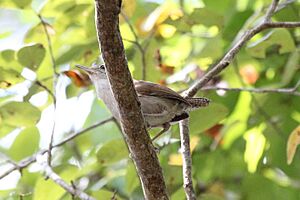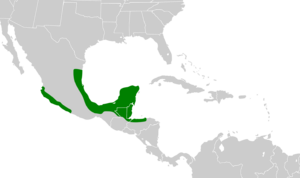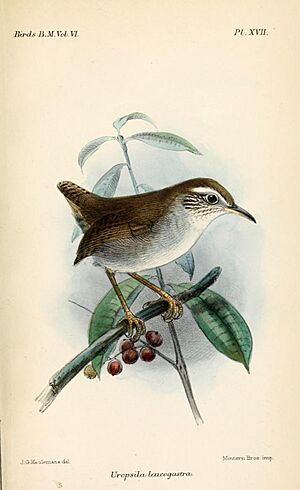White-bellied wren facts for kids
The white-bellied wren (Uropsila leucogastra) is a small bird that belongs to the Troglodytidae family, also known as the wren family. You can find this bird in countries like Belize, Guatemala, Honduras, and Mexico.
Quick facts for kids White-bellied wren |
|
|---|---|
 |
|
| Conservation status | |
| Scientific classification | |
| Genus: |
Uropsila
|
| Species: |
leucogastra
|
 |
|
Contents
About the White-bellied Wren
The white-bellied wren is the only species in its group, called Uropsila. Scientists sometimes disagree on how many different types, or subspecies, of this wren exist. Some say there are five, while others list more. These different types mostly vary in small details like their color or the patterns on their tails.
What Does the White-bellied Wren Look Like?
This little bird is about 9.5 to 10 cm (3.7 to 3.9 in) long. That's roughly the length of a smartphone! Male wrens weigh a bit more than females. Males are around 9.8 to 10.5 g (0.35 to 0.37 oz), and females weigh about 8 to 9.1 g (0.28 to 0.32 oz).
The white-bellied wren has a medium brown head, back, and tail. Its lower back, called the rump, looks a bit reddish. Its tail has many thin, dark stripes. It has a gray-white stripe above its eye, like an eyebrow. A brown stripe runs behind its eye, and its cheeks are gray with brown spots. Its throat, chest, and upper belly are gray. The sides of its body and the area around its tail are a buff color, which is a pale yellowish-brown. Different subspecies might have slightly different shades of brown or tail patterns.
Where Do White-bellied Wrens Live?
White-bellied wrens live in two main areas that are far apart. One group lives in western Mexico, from the state of Nayarit down to Guerrero. The other group is found in northeastern Mexico, stretching south into the Yucatan Peninsula, Belize, and northern Guatemala. There's also a slightly separate group in northern Honduras.
These wrens can live in many different kinds of forests. They are found in dry forests in western Mexico and also in very wet rainforests in the Yucatan Peninsula. In northeastern Mexico, they often hang out in thick bushes of wild pineapple plants, called Bromelia pinguin. They can live anywhere from sea level up to about 500 m (1,600 ft) high.
How Do White-bellied Wrens Behave?
What Do White-bellied Wrens Eat?
The white-bellied wren looks for insects and spiders to eat. It searches for food in plants, from the ground all the way up to high branches. In the southern parts of its home range, these wrens sometimes join groups of other bird species. They follow swarms of army ants, eating the insects that the ants stir up.
White-bellied Wren Reproduction
The breeding season for the white-bellied wren usually starts in late March and lasts until June. Their nests are shaped like a chemical flask, which is an oval ball with a funnel-like entrance pointing downwards. They build their nests using fine grass and decorate them with things like lichens and moss. These wrens often place their nests in thorny spots, such as in a Bromelia bush or an Acacia tree, to keep them safe.
A female wren usually lays four eggs. Both the male and female wrens seem to take turns sitting on the eggs to keep them warm. Both parents also work together to feed the baby birds once they hatch.
What Do White-bellied Wrens Sound Like?
The song of the white-bellied wren is a short series of about six quick notes that go up and down, then drop at the end. It sounds a bit bubbly if you hear it from wrens in the eastern part of their range. Their calls include a low "chek" sound, a scolding chatter, and a dry, cracking rattle.
Is the White-bellied Wren Safe?
The IUCN, which is a group that checks on the health of animal populations, says the white-bellied wren is a species of "Least Concern." This means they are not currently in danger of disappearing. They are quite common in many places where they live. These wrens can also handle some changes to their habitat, and they live in several protected areas, which helps keep them safe.



